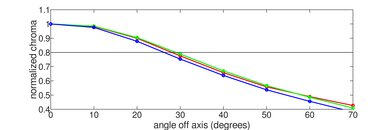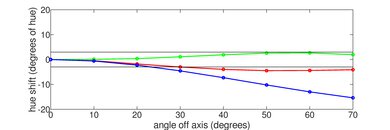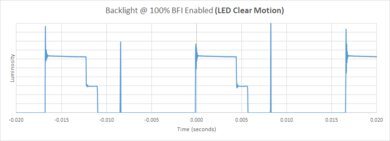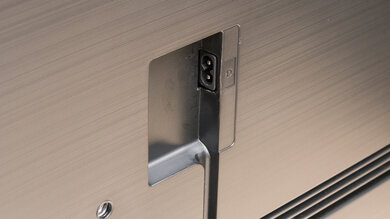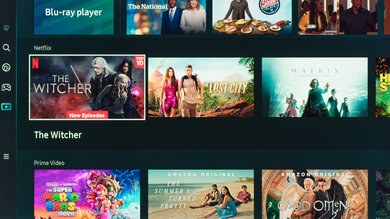The Samsung Q70C QLED is the mid-range model in Samsung's 2023 QLED lineup and succeeds the Samsung Q70/Q70A QLED and Samsung Q70B QLED. The TV doesn't have local dimming to improve its contrast, but it's fully featured for gaming. It has up to 4k @ 120Hz support on all four of its HDMI 2.1 bandwidth ports and support for every variable refresh rate (VRR) technology for a nearly tear-free gaming experience from any VRR-enabled source. As for advanced format support, the TV supports advanced Dolby audio formats through ARC/eARC. While it doesn't support Dolby Vision HDR, it has Samsung's competing HDR10+ format. It uses Samsung's Quantum Processor 4k for its image processing features. It comes with the 2023 version of Samsung's proprietary Tizen OS, and the TV has microphones in both the remote and the TV for hands-free voice control through the Alexa or Bixby voice assistants. It's available in four sizes: 55, 65, 75, and 85 inches.
Our Verdict
The Samsung Q70C is a decent TV overall, although it's best in situations where its fantastic input lag can be put to good use, like when gaming or when using the TV as a PC monitor. It's also not a great TV if you want to watch it with friends in a wide seating area, as its viewing angle is sub-par. Otherwise, its SDR brightness is very good, and its reflection handling is decent, so it can easily handle rooms with a few lights or windows when watching SDR content, like sports or TV shows. Its HDR brightness is adequate; good enough for dark rooms but not good enough to make HDR highlights pop in movies or games. Its response time is good, so fast-moving objects in sports, movies, or games have a little blur but nothing too noticeable.
- Very good SDR peak brightness.
- Decent reflection handling.
- Sub-par viewing angle.
- Doesn't have local dimming to improve its contrast.
The Samsung Q70C is decent for watching TV shows. It has very good brightness in SDR and decent reflection handling, so it can easily handle a few lights or windows in moderately-lit rooms. The TV has decent image processing, with decent low-resolution upscaling and acceptable low-quality content smoothing. So TV shows look satisfactory overall, whether from DVDs, cable, or streaming platforms. Unfortunately, the TV has a sub-par viewing angle, so this isn't a good choice for a wide seating arrangement, like if the entire family wants to watch shows together.
- Very good SDR peak brightness.
- Decent reflection handling.
- Decent low-resolution upscaling.
- Sub-par viewing angle.
The Samsung Q70C is decent for watching sports, but not with your friends in a wide seating area, as it has a sub-par viewing angle. It has very good brightness in SDR and decent reflection handling, so the TV can easily handle a few lights or some glare. It also has a good response time with most content, so there's a bit of blur behind fast-moving objects, like a ball or a puck zipping around the scene, but it's not annoying. Finally, the TV has decent gray uniformity. However, sports with uniform areas of bright color, like hockey, have noticeable uniformity issues, with regions of the image being visibly darker than others.
- Good response time with most content.
- Very good SDR peak brightness.
- Decent reflection handling.
- Decent low-resolution upscaling.
- Sub-par viewing angle.
The Samsung Q70C is good for gaming. The TV has many gaming-oriented features, like four HDMI 2.1 bandwidth ports, all supporting up to 4k @ 120Hz gaming, and support for every VRR technology for nearly tear-free gaming from any VRR-enabled source. Its input lag is fantastic, so inputs are fast and responsive. It also has a good response time with most content, with a little blur behind fast-moving objects but nothing too annoying. However, this isn't a good TV for fans of horror games or any other games that lean towards a dark color palette, as the TV's response time is significantly worse in dark scene transitions. The TV has good contrast, although games don't look vibrant overall without a local dimming feature. The TV gets bright in SDR and has decent reflection handling, so games look good in a moderately-lit room.
- Good response time with most content.
- Very good SDR peak brightness.
- Extremely low input lag.
- Has four HDMI 2.1 bandwidth ports with VRR.
- Decent reflection handling.
- Decent low-resolution upscaling.
- Slow response time in dark scene transitions.
The Samsung Q70C is a fair TV for movie lovers. It has adequate contrast, but unfortunately, it doesn't have a local dimming feature to make the TV's blacks deep and dark, so they look a bit blue in dark scenes. It has adequate HDR brightness, good enough for a pleasant viewing experience, but highlights don't pop. The TV has acceptable low-quality content smoothing, so low-bitrate content watched from streaming platforms looks fine overall but with noticeable macro-blocking in dark scenes. The TV's color accuracy is also mediocre pre-calibration; you don't need to calibrate it to look good, but it's helpful if you care about accuracy.
- Automatically removes 24p judder from all sources.
- Doesn't have local dimming to improve its contrast.
- Mediocre color accuracy pre-calibration.
The Samsung Q70C is a good choice for gamers wanting to play the latest HDR games. It has four HDMI 2.1 bandwidth ports, all capable of up to 4k @ 120Hz, and supports every VRR technology for a nearly tear-free gaming experience from any VRR-enabled source. It has a good response time with most content, with a bit of blur around fast-moving objects but nothing too noticeable. However, the TV's response time is significantly worse in dark scene transitions, so it's not optimal for dark games, like titles in the horror genre. The TV's HDR brightness is adequate for a dark room, as games look bright enough for a pleasant HDR gaming experience, although highlights don't pop much.
- Good response time with most content.
- Extremely low input lag.
- Has four HDMI 2.1 bandwidth ports with VRR.
- Slow response time in dark scene transitions.
- Doesn't have local dimming to improve its contrast.
- Mediocre color accuracy pre-calibration.
The Samsung Q70C is very good to use as a PC monitor. It has a good response time, so there's a little blur when moving windows around, but it's not annoying in practice. However, make sure not to set your operating system to 'dark' mode, as the TV's response time performs significantly worse in dark scene transitions, leading to black smearing. Otherwise, the TV's input lag is fantastic, so your mouse or controller inputs are super responsive. It displays chroma 4:4:4 signals properly, which is essential for clear text from a PC. It has good SDR brightness and decent reflection handling, so the TV easily handles moderately-lit offices. Unfortunately, the TV's viewing angle is sub-par, so the sides of the screen fade and look washed out if you're sitting too close.
- Good response time with most content.
- Very good SDR peak brightness.
- Extremely low input lag.
- Has four HDMI 2.1 bandwidth ports with VRR.
- Decent reflection handling.
- Slow response time in dark scene transitions.
- Sub-par viewing angle.
- Mediocre color accuracy pre-calibration.
Changelog
- Updated Sep 24, 2024: Mentioned the newly-reviewed Samsung Q70D QLED in the HDR Brightness section of this review.
- Updated Aug 08, 2024: We retested support for DTS Audio Passthrough and updated our results to clarify that the TV doesn't support DTS audio formats.
- Updated May 27, 2024: Clarified that the TV uses the Quantum Processor 4k and not the Neural Quantum Processor 4k in the Introduction section.
- Updated Aug 21, 2023: Review published.
Check Price
Differences Between Sizes And Variants
We tested the 65-inch Samsung Q70C, and the results are valid for the 55, 75, and 85-inch models. The last four letters of the model code (in this case, FXZA) vary between regions and even retailers, and not all regions carry all the variants. As Samsung's European lineup differs, these results are only valid for the North American Q70C.
| Size | US Model | Short Model Code |
|---|---|---|
| 55" | QN55Q70CAFXZA | QN55Q70C |
| 65" | QN65Q70CAFXZA | QN65Q70C |
| 75" | QN75Q70CAFXZA | QN75Q70C |
| 85" | QN85Q70CAFXZA | QN85Q70C |
Our unit was manufactured in February 2023; you can see the label here.
Popular TV Comparisons
The Samsung Q70C is a decent TV overall, more so for gamers, as it's a fully featured gaming TV with four HDMI 2.1 bandwidth ports. But as with other models in Samsung's QLED range, it comes up short compared to other products in the same market position or price range. There are superior models available from budget manufacturers, like the TCL Q7/Q750G QLED, but especially the much better Hisense U8/U8H. The cheaper Sony X85K is also better than the Samsung Q70C overall, except for PC monitor usage, and you can even find the much better Sony X90K/X90CK for about the same price as the Samsung. Other TVs have better value overall unless you find the TV for a great price.
For more options, check out our recommendations for the best 4k TVs, the best 4k gaming TVs, and the best QLED TVs.
The Samsung Q70A and the Samsung Q70C are extremely similar TVs, although the Q70A has a small edge in most categories. The older model has better image quality, with better contrast, is slightly brighter in both HDR and SDR, is significantly more accurate pre-calibration, and has better black uniformity. However, the Q70C does have better image processing, with better low-quality content smoothing and better upscaling capabilities. Finally, it has four HDMI 2.1 bandwidth ports versus only one for the Q70A, which is great if you have multiple HDMI 2.1 devices.
The Samsung Q70D is a bit better than the 2023 Samsung Q70C. The Q70D is brighter overall, so it overcomes more glare in a bright room and displays brighter highlights in HDR content. It also has a slightly better contrast ratio for deeper blacks during dark scenes and is the more accurate TV.
The Samsung Q70C is better than the LG QNED80 2023. The Samsung has a higher native contrast ratio, so it looks better in dark rooms, with deeper blacks and better black uniformity. The Samsung also gets brighter, and HDR content looks better in general.
The Samsung Q80C is a bit better than the Samsung Q70C. The Q80C has a much wider viewing angle than the Q70C, great for watching with friends in a wide seating area. The Q80C also has local dimming to slightly improve its contrast, although its local dimming feature is mediocre. It gets a bit brighter than the Q70C in both SDR and HDR, has better color volume, and has a faster response time with much better dark scene transitions. Otherwise, they both have the same set of gaming features.

We buy and test dozens of TVs yearly, taking an objective, data-driven approach to deliver results you can trust. Our testing process is complex, with hundreds of individual tests that take over a week to complete. Most of our tests are done with specially designed test patterns that mimic real content, but we also use the same sources you have at home to ensure our results match the real-world experience. We use two main tools for our testing: a Colorimetry Research CR-100 colorimeter and a CR-250 spectroradiometer.
Test Results

As part of our two-year test, which has so far subjected 100 TVs to over 10,000 hours of accelerated testing, we found that edge-lit TVs like this one have significant durability issues. These issues range from warped reflector sheets and cracked light guide plates to completely burnt-out LEDs. You can read the full results of our investigation here.
The stand feels a little cheap; it's made of plastic and feels hollow when you tap it. However, it's big and supports the TV very well; there's minimal wobble when you touch the TV. The stand lifts the TV about 3.15" above the table, so most soundbars fit in front of it without blocking the screen.
Footprint of the 65-inch stand: 13.6" x 11.5".
The back of the TV is plastic with fine horizontal etchings, and it feels solid overall, without excessive flex around the VESA holes or inputs. There are grooves on the back of the TV and the stand for cable management. The inputs are recessed in an inlet on the side of the TV, and they're hard to reach if the TV is wall-mounted.
Overall, the Samsung Q70C has good build quality. The TV has an all-plastic build, but it still feels solid. The stand holds the TV well, and there's minimal wobbling when pushing or moving the TV. The back panel exhibits minimal flex, although there's more of it around the VESA holes or the inputs, but it isn't excessive and won't cause any issues.
The Samsung Q70C has a very good native contrast ratio, but there's no local dimming to improve it further. This means that blacks look good in a dark room but look a bit blue when bright highlights are on the screen, as the TV can't emphasize bright highlights without impacting dark areas.
This TV doesn't have a local dimming feature; as bright highlights don't move from zone to zone, there's no distracting flicker or brightness changes as they move across the screen.
The Samsung Q70C has adequate HDR brightness. It doesn't vary from scene to scene, but as the TV lacks a local dimming feature, highlights don't stand out against the rest of the image.
These measurements are after calibrating the HDR white point, with the following settings:
- Picture Mode: FILMMAKER Mode
- Brightness 50
- Contrast: 50
- Color Tone: Warm 2
- HDR Tone Mapping: Static
- Color Space Settings: Auto
While we tested with HDR Tone Mapping set to 'Static' as it's more accurate, setting it to 'Active' makes the image brighter in some scenes, as you can see with the results below:
- Hallway Lights: 275.8 cd/m²
- Yellow Skyscraper: 345.2 cd/m²
- Landscape Pool: 155.5 cd/m²
If you like this TV but need better HDR brightness, check out the 2024 Samsung Q70D QLED.
The TV is slightly brighter overall in Game Mode, but it's not a noticeable difference, and it's still too low for a truly good HDR experience.
These measurements are after calibrating the HDR white point, with the following settings:
- HDR Picture Mode: Game
- Brightness: 50
- Contrast: 50
- Color Tone: Warm2
- HDR Tone Mapping: Static
- Color Space Settings: Auto
- HDR10+ Gaming: Off
- Game HDR: Basic
While we tested with HDR Tone Mapping set to 'Static' as it's more accurate, setting it to 'Active' makes the image brighter in some scenes, as you can see with the results below:
- Hallway Lights: 342.4 cd/m²
- Yellow Skyscraper: 407.6 cd/m²
- Landscape Pool: 202.8 cd/m²
The PQ EOTF tracking is excellent on this TV. Dark scenes and midtones are displayed close to the content creator's intent. Near-blacks are raised, however, but this is typical of LED TVs. Besides that, the TV tracks the content creator's intent very well. There's a sharp cutoff near the TV's peak brightness, though, which causes a loss of fine details in bright highlights.
The Samsung Q70CD has very good SDR peak brightness. It's bright enough to overcome glare in a moderately-lit room, and there's minimal variation in brightness in most scenes.
These measurements are after calibration with the following settings:
- Picture Mode: Movie (Calibrated)
- Brightness: 50
- Color Tone: Warm2
The Samsung Q70CD has a good color gamut. It has excellent coverage of the common DCI-P3 color space, which is used in most HDR content. Unfortunately, most of its color range is undersaturated, even more so in greens and yellows. Its coverage of the less widely used Rec. 2020 color space is passable, but it's even more undersaturated here than in the DCI-P3 space.
The TV has a decent color volume. However, it struggles with both dark saturated colors and very bright colors; in particular, the TV has a really hard time with greens, as they're not nearly as bright and saturated as they'd be on an ideal TV. Yellow and reds also deviate from the ideal, as they are undersaturated.
The Samsung Q70C has mediocre pre-calibration accuracy. Its color temperature is very cold, leading to an exaggerated blue tint in all scenes. Its white balance is also off, with dark grays being too red and brighter whites being too blue. Gamma doesn't follow our 2.2 target for moderately-lit rooms, and all scenes end up being darker than they should be, especially very dark scenes.
The TV is challenging to calibrate, taking some work to make the TV look good. Blues and reds are especially hard to calibrate here. Still, it looks fantastic afterward.
You can see our full calibration settings here.
The TV has satisfactory gray uniformity. There are some visible uniformity issues, with noticeable vignetting. There's some banding in parts of the screen and a bit of dirty screen effect. These uniformity issues are noticeable if you want to use the TV as a PC monitor or watch content with large areas of bright uniform color, like hockey. On darker colors, there's noticeable backlight bleeding, with the corners and sides of the image being blueish compared to the center.
The Samsung 75Q70C has a sub-par viewing angle. The image shifts significantly when viewed at an angle, so this isn't a good TV for a wide seating arrangement or if you like to move around the TV while watching it.
The Samsung Q70C has okay HDR gradient handling. There's noticeable, but not egregious, banding in every color gradient except light grays/whites and bright reds.
The TV has decent upscaling and sharpness processing. Fine details in low-resolution content are displayed well, but text is a bit blurry, and the scene looks a bit soft overall.
The optimal sharpness settings for low-resolution or low-bitrate content, with no over-sharpening, are as follows:
- Sharpness: 6
- Picture Clarity: Off
The Samsung Q70C uses a BGR subpixel layout. This doesn't affect the image quality, but non-RGB subpixel layouts cause issues when used as PC monitors, as they reduce text clarity. There are workarounds, however, and you can read more about it here.
The Samsung Q70C uses pulse width modulation (PWM) to dim the backlight at all brightness levels. It flickers at 960Hz in the 'Movie' Picture Mode, which is fast enough that most people won't notice it. It does, however, drop down to 120Hz if any form of motion interpolation is enabled. The TV flickers at 120Hz in all other modes and at 60Hz with LED Clear Motion enabled in the 'Movie' or 'Game' Picture Modes.
The TV has an optional backlight strobing feature, commonly known as black frame insertion. It can only flicker at 60Hz on this TV, which is slow enough to be noticeable. It's meant to reduce persistence blur, but it duplicates images and reduces the panel's brightness, so it's distracting to use.
This TV has an optional motion interpolation feature to improve the appearance of motion. It can increase the frame rate of content up to 120fps. Unfortunately, it doesn't work well on this TV, resulting in image duplications and artifacts, especially during fast action scenes.
The TV's performance regarding stutter is decent; there's visible stutter with low-frame rate content, like when watching movies, but 60fps content looks fantastic.
The TV removes 24p judder from any source, ensuring a smooth movie-watching experience. Picture Clarity must be set to 'Custom' with the sliders set to 0 to remove 24p judder from 60Hz sources.
The Samsung Q70C supports every variable refresh rate (VRR) technology, so you can get a nearly tear-free gaming experience no matter your gaming system.
The TV has superbly low input lag in Game Mode, ensuring a responsive gaming and desktop experience.
The TV supports all common resolutions up to 4k @ 120Hz. It also displays clear text with proper chroma 4:4:4, as long as you set the input to PC and have Input Signal Plus enabled on the HDMI port that your PC is connected to.
This TV can take full advantage of the PlayStation 5, with full 4k @ 120Hz and HDMI Forum VRR support. The Auto Low Latency Mode automatically switches the TV into Game Mode when you play a game from a compatible device.
This TV can take full advantage of the Xbox Series X or S, with full 4k @ 120Hz, HDMI Forum VRR, and FreeSync support. The Auto Low Latency Mode automatically switches the TV into Game Mode when you play a game from a compatible device.
The Samsung Q70C doesn't support Dolby Vision, but it does support Samsung's less widely used HDR10+ format. Otherwise, the TV has four HDMI 2.1 bandwidth ports, all capable of up to 4k @ 120Hz.
The TV has eARC support, which allows it to pass uncompressed high-quality audio from a connected source to your home theater system or soundbar. Unfortunately, it doesn't support any DTS formats commonly used on Blu-rays.
The TV has a mediocre frequency response. It has barely any bass, and its sound reproduction becomes less accurate as you raise the volume. There's also a fair amount of compression artifacts, so it doesn't sound good at max volume. The TV's midtones sound good at a moderate listening volume, so dialogue is easy to understand.
The TV's distortion performance is middling. At or near max volume, the TV's speakers significantly distort the sound. It's better at moderate volumes but still not great. Distortion depends on the content, and not everyone is sensitive to it.
The Samsung Q70C uses the 2023 version of Samsung's Tizen OS. It's a bit slow right after you turn on the TV, but it's smooth and fast afterward. Finding content is easy, and moving between apps and inputs is intuitive.
The Samsung Q70C uses the 2023 version of Samsung's remote control. There are buttons dedicated to specific streaming apps, which vary by region. It also has an integrated microphone for voice commands, and the TV comes with Bixby and Amazon's Alexa voice assistants. Aside from the mic in the remote, the TV itself has an integrated microphone for hands-free voice control. Voice commands work well; you can change the input, ask to open specific apps, ask for time or the weather, or even tell the TV to change the intensity of its backlight. The remote has a rechargeable battery, which you can charge through USB-C or with solar energy.





























